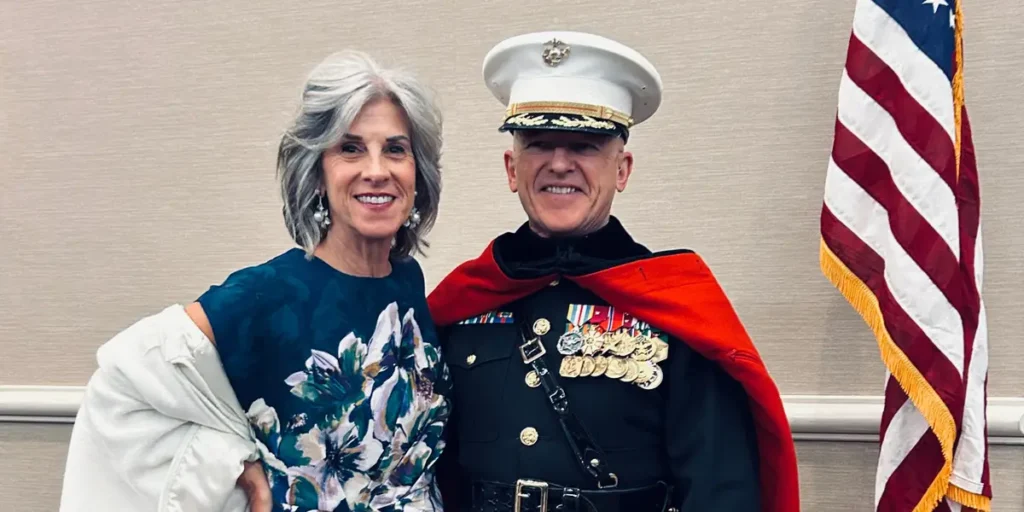Every November, Marines dust off one of the rarest and most distinctive pieces in their wardrobe — a sweeping navy cloak lined in scarlet known to turn heads.
The boat cloak, a uniquely Marine Corps flourish, makes its rare appearance during Marine Corps birthday balls, traditions observed in every unit on November 10. This year, the Marines, like the Army and Navy, celebrated their 250th birthday.
The cloaks hold a special kind of reverence within the Corps, typically worn by Marines only for the ball with their most formal dress, and even then, it’s exceptionally rare, making it all the more striking when one of these unique cloaks shows up.
One cloak that appeared at a local gala this year has been passed down over nearly 80 years.
“It is very majestic,” said Thomas Connally, the current custodian of the cloak. “It adds a little something to the whole flair.”
Connally, a retired Marine colonel, still attends the local ball each year and dons his formal Marine attire, including the cloak if it’s not too warm. It’s a conversation starter, he said, and he’ll even let others try it on — as long as they’ll listen to him explain its history.
It was hidden away for nearly 30 years, shared Mike Anderson, a retired Navy rear admiral whose father, a Marine officer who served in World War II and later Korea, originally purchased the cloak sometime in the 1950s. Anderson held on to the cloak after it was passed down, but he never wore it. Though he became the Corps’ top medical officer, he was a sailor, and only Marines wear the special boat cloak.
Anderson decided to pass the cloak on to two family friends, Connally and his brother, also a Marine, in the 1990s.
Few military uniforms are quite as ostentatious as Marine dress blues, Connally said, referring to a big part of the Marines’ naval heritage. The boat cloaks take it a step further.
Courtesy of Thomas Connally
Cloaks were once common for the US military, explained Charles W. McFarlane, a military clothing historian who runs a Substack on the topic called “Combat Threads.”
The concept, he said, was that a shapeless, warm outer garment that fastens at the throat was much easier to wear with formal attire, especially if naval officers had to travel from ship to shore. A coat is also impractical when fancy dress consists of bulky fourragères, special braided cords that adorn the shoulders of some members of select units and other accouterments like medals or rank. A cloak is less hassle and also looks cooler.
In their histories, “the Army, the Navy, and the Marine Corps have all had some version of a boat cloak,” McFarlane said.
The Navy’s version was similar to that of the Corps. That service, however, outlawed it from being worn a decade ago. The Army appears to still allow for its cloaks to be worn, but only by officers, an idea rooted in European military tradition, which has historically had firmer class distinctions, said McFarlane.
The Corps allows officers and senior enlisted alike to wear the boat cloak, but it’s rarely seen on junior officers, or at all.
Female Marines wear a shorter version of this unique garment, more of a cape than a cloak. The Corps had at one point considered allowing women to wear the full-length version, though it’s unclear what became of that proposal. McFarlane said that the distinction dates back to mid-20th-century fashion. More women served in uniform after World War II, and their military dress capes were modeled on the shorter evening capes popular with civilian women at the time, designed to show off the gown beneath.
Perhaps the most famous wearer of a naval cloak was President Franklin D. Roosevelt, who wore a naval cape throughout his tenure as president, famously at 1945 Yalta Conference. He is depicted in his memorial statue wearing one. Prior to his presidency, he served as assistant secretary of the Navy.
Among the various US military cloaks, the Marine Corps’ boat cloak stands out, but despite all the lore and fascination surrounding it, the cloak is not often seen. A new one costs about $850 through the official Marine uniform shop. McFarlane said Marines could have one made privately, but few tailors are trained for such intricate military creations.
There’s been rising cultural attention around the boat cloak, though, especially as Marines showcase them on social media. “I’ve been seeing a lot more videos and reels and TikToks that bring up the boat cloak,” he said, adding that such attention could cultivate more interest and wear.
Asked about what the future holds for the Anderson-Connally cloak, Thomas Connally said that he is likely to pass the cloak onto his children, a son and daughter who are both Marine officers.
“It’s a substantial piece of work,” he said. “It’ll keep you warm and, you know, it’s built for the mission.”



